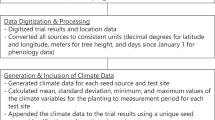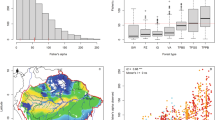Abstract
THE sycamore maple, Acer pseudoplatanus L., is one of the hardiest of British trees, sometimes suppressing the elm by the vigour and rapidity of its growth. According to Henry1 it thrives in almost any dry soil, and seems to reach its greatest size and perfection in the colder hilly parts of England and Scotland, “where nearly all the finest specimens are found”. It is unaffected by the severest frosts, at any season, and is rarely attacked seriously by insects, or by fungi except Rhytisma acerinum (Pers.) Fries, which produces noticeable black blotches on the leaves. The sycamore maple ripens seed profusely and reproduces itself almost everywhere on clean ground, though the seedlings are easily suppressed by coarse grass. Bean2 notes that its seedlings spring up in the wilder parts of Kew Gardens in such a way that in course of time the place, if left to run wild, would probably become a sycamore forest. He points out that this is one of the few trees that will stand the full force of salt-laden winds in exposed places near the sea. Last year I found it growing on the coast of Caithness exposed to the full fury of the north wind.
This is a preview of subscription content, access via your institution
Access options
Subscribe to this journal
Receive 51 print issues and online access
$199.00 per year
only $3.90 per issue
Buy this article
- Purchase on Springer Link
- Instant access to full article PDF
Prices may be subject to local taxes which are calculated during checkout
Similar content being viewed by others
References
Henry, A., in Elwes and Henry, “Trees of Great Britain”, vol. 3, pp. 645–646; 1908.
Bean, W. J., “Trees and Shrubs Hardy in the British Isles”, (2nd ed.), vol. 1, p. 155; 1919.
Smith, Sir J. E., “Flora Britannica”, vol. 1, p. 422; 1804.
Ray, John, “Synopsis Methodica Stirpium Britannicarum”, p. 230; 1690.
Turner, William, “A Newe Herball”, Part 1; 1551.
Gerarde, J., “The Herball”, 1597; and edit. 2, enlarged and amended by Thomas Johnson, 1633.
Hyde, H. A., “Welsh Timber Trees”, p. 86; 1931.
Reid, Clement, “The Origin of the British Flora”, p. 16; 1899.
Culpepper, N., “The English Physitian”, enlarged. London, 1653. Many subsequent editions appeared; Dr. Daydon Jackson mentions one in Welsh, issued in Caermarthen in 1818; my own copy was published at Halifax, but bears no date.
Wells, J., “Oxford and its Colleges”, 13th ed., p. 21; 1926.
Author information
Authors and Affiliations
Rights and permissions
About this article
Cite this article
DAVY, J. An Early Record of the Sycamore Maple in Britain. Nature 134, 61–62 (1934). https://doi.org/10.1038/134061a0
Issue Date:
DOI: https://doi.org/10.1038/134061a0
This article is cited by
-
The Sycamore Maple in A.D. 1300
Nature (1934)
Comments
By submitting a comment you agree to abide by our Terms and Community Guidelines. If you find something abusive or that does not comply with our terms or guidelines please flag it as inappropriate.



